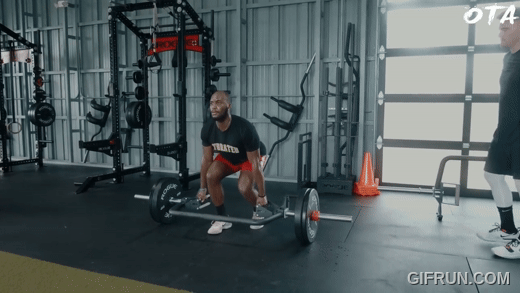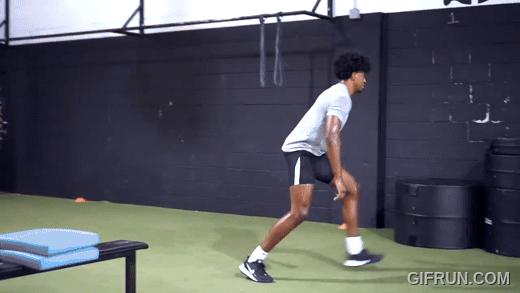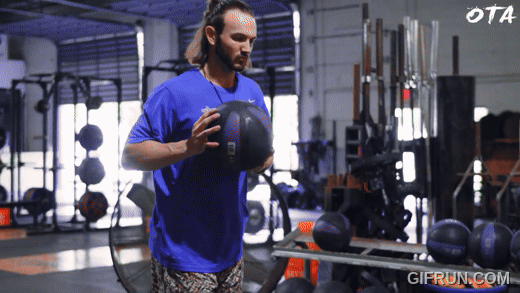The Speed Equation: Unlocking Linear Speed in Athletes
Linear speed is a highly coveted attribute in many sports. Whether it’s sprinting down the field in football, closing out on a shooter in basketball, or chasing down an opponent in soccer, athletes are constantly seeking ways to increase their speed. But here’s the truth: speed is not a simple matter of just running faster. Optimal speed development requires a holistic approach that integrates various components of athletic performance.
In this post, we’ll explore how developing speed in athletes is far more than just running sprints. To unlock an athlete’s linear speed potential, we need to consider factors such as force development, resistance training, mobility, recovery, and the critical need for mechanical efficiency. Understanding and implementing these components together creates what I like to call “The Speed Equation.” Let’s break it down.

1. Speed Development Is Not Just About Sprinting
When athletes or coaches think about improving speed, the first thing that often comes to mind is sprinting. While it’s true that sprinting plays a central role in developing linear speed, it cannot be viewed in isolation. Speed development requires a holistic approach, where sprinting is only one piece of the puzzle. There are several other factors that need to be aligned and trained simultaneously to achieve optimal results.
Simply putting an athlete out on the track and having them sprint might show some initial improvements, but this approach lacks specificity and sustainability. In order to reach their full potential, athletes need to address multiple key components: force development, strength training, mobility, and recovery. All these factors must work together to create a solid foundation for speed.
By integrating these elements, athletes will see far more substantial and lasting improvements in their sprinting performance over time. It’s not just about running fast—it’s about becoming more efficient and powerful in every aspect of your movement.

2. The Role of Strength Development in Speed
One of the most important but often overlooked factors in speed development is strength training, specifically absolute strength. Absolute strength refers to the maximum amount of force an athlete can generate, regardless of their body weight or size. This is a foundational element for enhancing sprinting performance, and here’s why.
When we break down the action of sprinting, it is essentially a series of explosive movements that require a lot of force to push the body forward. Sprinting requires athletes to generate maximal force against the ground in a very short amount of time. This is where absolute strength comes into play. Athletes with higher absolute strength have the ability to produce more force, which directly translates into improved speed.
For example, exercises like deadlifts, squats, and lunges build the lower body strength needed to create more power in the drive phase of a sprint. When an athlete develops greater absolute strength, they are able to transfer more power into each stride, allowing them to accelerate more quickly and maintain top speeds for longer.
3. Horizontal vs. Vertical Force: A Dual Focus for Speed
A key factor that many coaches overlook is the importance of horizontal and vertical force development. These two types of force play different yet equally important roles in an athlete’s sprinting mechanics.
- Horizontal Force: During the initial phase of a sprint, often referred to as the drive phase, athletes need to focus on applying horizontal force. This is the force directed backward into the ground that propels the athlete forward. The first 10 to 15 yards of a sprint are critical for an athlete to accelerate quickly. The more horizontal force an athlete can apply, the faster they can get off the line and build speed.
- Vertical Force: Once the athlete reaches a more upright position, the sprint shifts to a more cyclical motion, with a focus on vertical force. This is when the athlete’s foot strikes the ground more vertically, and the emphasis shifts to pushing downward into the track. At this point, vertical force becomes more important in maintaining top speed and stability as the athlete continues to drive forward.
Both types of force are critical to sprinting performance, and it’s important that they are developed consciously. This means that training should not only include random drills or exercises, but rather should be specifically designed to enhance an athlete’s ability to produce horizontal force in the drive phase and vertical force in the max velocity phase. By targeting these forces with appropriate exercises, such as sled sprints (for horizontal force) and bounding or depth jumps (for vertical force), athletes can improve both their acceleration and top-end speed.

4. Identifying Weaknesses Through Evaluation
In any training program, it’s essential to assess an athlete’s strengths and weaknesses. Speed development is no different. A comprehensive evaluation of an athlete’s speed, force, and strength is necessary to identify the areas that need improvement.
For example, if an athlete is already fast but struggles with explosive starts, the issue might lie in their force production during the acceleration phase. If they have a strong drive but cannot maintain top speed, it could be a matter of vertical force or even stamina. If an athlete has a good sprint time but lacks strength, then improving their absolute strength could be the key to unlocking greater power and speed.
By identifying these weaknesses, coaches can tailor their training programs to focus on the areas that will provide the most benefit. If an athlete’s absolute strength is lagging, for example, prioritizing strength training (such as compound lifts like deadlifts and squats) can help address this deficiency. On the other hand, if sprint mechanics are off, specific drills focusing on improving posture and technique during sprinting should be added to the training plan.
5. Sprint Mechanics, Mobility, and Core Strength
While strength and force development are crucial, mechanical efficiency is also key to unlocking an athlete’s linear speed. This is where sprint mechanics, mobility, and core strength come into play.
- Sprint Mechanics: Sprinting is a highly technical skill, and many athletes struggle with improper mechanics that limit their speed. Common issues include inefficient stride patterns, poor posture, or a lack of coordination between the upper and lower body. Coaches should regularly assess and correct these mechanics, ensuring that athletes are running in the most efficient manner possible.
- Mobility: Tight muscles, especially in areas like the hip flexors, can severely limit an athlete’s stride length and overall sprinting efficiency. Mobility training should be a part of every speed development program to ensure that athletes can get into the proper positions during the sprint and avoid any physical restrictions.
- Core Strength: A strong core is critical for maintaining stability and posture while sprinting. Without core strength, athletes risk collapsing their posture, which can drastically reduce their speed. Core exercises like planks, Russian twists, and cable chops should be included in the training regimen to improve stability and posture during high-speed movements.

Conclusion
To unlock an athlete’s linear speed, it’s essential to take a comprehensive, holistic approach. Simply running sprints is not enough—speed development requires force development, resistance training, sprint mechanics, mobility, and core strength all working together in unison. By developing both horizontal and vertical forces, focusing on strength, identifying weaknesses, and correcting mechanical issues, athletes can maximize their speed potential and achieve lasting improvements.
Ultimately, the “Speed Equation” involves more than just running fast; it’s about becoming a more powerful, efficient, and well-rounded athlete. By addressing all these components, athletes can build a solid foundation for speed and unlock their true sprinting potential!
